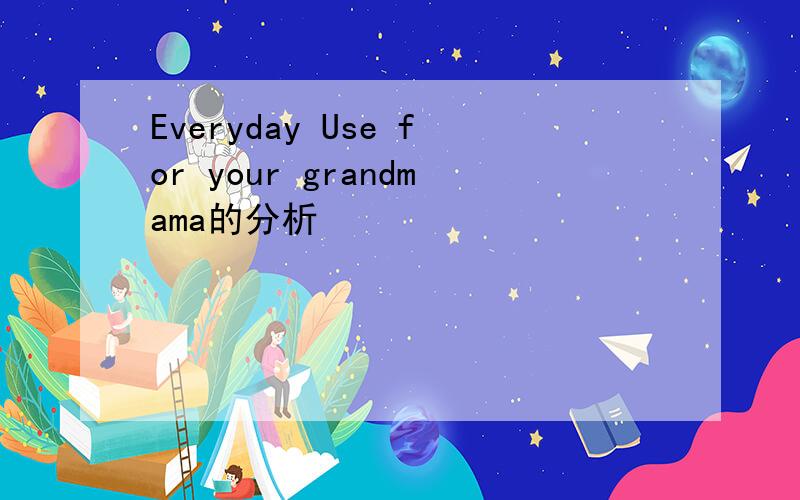Everyday Use for your grandmama的分析
来源:学生作业帮助网 编辑:作业帮 时间:2024/11/25 04:29:23

Everyday Use for your grandmama的分析
Everyday Use for your grandmama的分析
Everyday Use for your grandmama的分析
Everyday Use指日用品、日常用品
grandmama外祖母、奶奶
这句活是说为奶奶/外祖母准备的日用品
这篇文章其实是讲文化的冲突,如果你也在上高英的话,至于分析,你自己来吧
On the Conflict of the Short Story
“Everyday use for your grandmama” is a story about an Africa-American family’s daily life and their spiritual world, reflecting their embarrassed condition a...
全部展开
On the Conflict of the Short Story
“Everyday use for your grandmama” is a story about an Africa-American family’s daily life and their spiritual world, reflecting their embarrassed condition and cultural plight.
There are three primary characters in the passage: mom, Maggie
and Dee and their different characters form the conflicts in the story. The most incompatible conflict is their different views on the African culture. Mom and Maggie living a traditional way of the black clashed with Dee who praised the opinion of the white. Mom was a typical black woman, “large, big-boned, with rough, man-working hands” and little education. Doing very hard work like “knocking a bull calf straight in the brain with a sledge hammer” and “breaking ice to get water for washing”, she sustained the whole family laboriously. From her, we see the glittery virtue of hard working of the black women and the great love of a mother as well. Her little daughter Maggie was a shy and conservative girl inheriting the
culture from her mom. While without the beauty and braveness, she knew the exact way of THEIR life. However, Dee was very different from them. Accepting the education and culture of the white people, she knew little
about her culture, despised the black and even hated her identity. She hated their house very much and she did not want to bring her friends to her mom and sister. Her mother tolerated her, raised the money to send her to school and felt proud of her. But she returned this love by detesting and leaving the family. The great virtue and the bitter experience of the black could not evoke her respect and understanding, but the anger and shame instead. The infection of the white's culture made her ignoring the love and beauty of her family and her race.
However, Dee had a big change later. Influenced by the Black Power Movement, she got interested in her own culture. The house, the bench, the churn and the quilt, all these things that were used to make her disgusted delighted her then. Following the “fashion” of the movement, she intangibly and surprisingly found the “value” of her family. But it is a pity
that Dee only formed a shallow view on her culture. She said the language of the East Africa “a-su-so-tean-o” to her mother, knowing little that they came to America from West Africa. Neglecting the history and the love of the everyday use, she just wanted to keep them as ornaments to make a parade. Maggie, to the opposite, had a different view on the culture. Though did not realize the “value” of the everyday use, she knew everything's history------who made it, how to use it and how to make it. The typical representative of their culture is the quilt made from pieces of dresses. Through the skillful hands and united work, the old pieces turned into beautiful quilts, with lone star pattern and the picture of walk around
the mountain. These quilts are not only the reflection of the wisdom and diligence of the black women, but also impregnated with the love of the family members. Different from Dee’s opinion of “hanging them”, Maggie considered them to be a souvenir of the grandma Dee and she knew how to quilt herself. She would use them as quilts, as the way the black should do. In her hand, the quilts could hold that family-love and pass down from generation to generation, with the traditional living way of black people. Comparing with Dee, the real value of quilts could show only in Maggie’s hands. And that was why mom gave the quilts to Maggie at last.
Through the conflicts between the characters, the story reflects the conflict of the society to us. Dee is a black girl trying to enter the mainstream of America, namely the white world, well-educated but knowing little about her culture. Maggie is capable to pass down the precious culture, but she pays the price of living in a less-open environment and giving up high education. And that is the problem. Living in America, being educated in America and attempting to succeed in America inevitably force black people accept the opinions and living way of the white world, possibly make them forgetting or despising or abounding their culture. The disdaining and banishing to the black culture from the white world is the main reason of that. That is Dee who is typical
of the conflict between the black and the white world. Through the conflict, we see clearly the plight of furious collision between the two cultures and also the writer’s hope of preserving the blacks’ culture.
收起